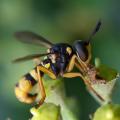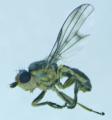Diptera.info :: Identification queries :: Diptera (adults)
Who is here? 1 guest(s)
|
Dark Blue Tachinid --> Eurithia sp.
|
|
| tristram |
Posted on 20-11-2010 23:37
|
|
Member Location: Reading, UK Posts: 1330 Joined: 27.06.10 |
I first thought this was Pales pavida but it doesn't have the reddish tip to its scutellum. Is it Epicampocera succinata?
tristram attached the following image:  [139.44Kb] Edited by tristram on 22-11-2010 00:42 |
| tristram |
Posted on 20-11-2010 23:38
|
|
Member Location: Reading, UK Posts: 1330 Joined: 27.06.10 |
From above:
tristram attached the following image:  [163.14Kb] |
| ChrisR |
Posted on 21-11-2010 01:06
|
|
Administrator Location: Reading, England Posts: 7699 Joined: 12.07.04 |
Hairy eyes and a projecting mouth edge? Should be Eurithia anthophila  It looks a bit too big for Epicampocera. It looks a bit too big for Epicampocera.EDIT: Epicampocera are quite dark-blue but the relative proportions of head to body are different too. Edited by ChrisR on 21-11-2010 01:10 Manager of the UK Species Inventory in the Angela Marmont Centre for UK Biodiversity at the Natural History Museum, London. |
| Zeegers |
Posted on 21-11-2010 10:52
|
|
Member Location: Soest, NL Posts: 18723 Joined: 21.07.04 |
Where is it from ? It is Eurithia, but not anthophila: the vertex is too narrow and the palpus is yellow, suggesting Eu. vivida, the most bluish Eurithia in my experience. Theo |
|
|
|
| ChrisR |
Posted on 21-11-2010 13:21
|
|
Administrator Location: Reading, England Posts: 7699 Joined: 12.07.04 |
Very interesting record if it is E.vivida - they're rare as hen's teeth in the UK 
Manager of the UK Species Inventory in the Angela Marmont Centre for UK Biodiversity at the Natural History Museum, London. |
| Zeegers |
Posted on 21-11-2010 14:13
|
|
Member Location: Soest, NL Posts: 18723 Joined: 21.07.04 |
is it from the UK and are we very VERY sure (too paraphrase the Spice Girls) that the pictures concern the same specimen ?? Theo |
|
|
|
| tristram |
Posted on 21-11-2010 21:32
|
|
Member Location: Reading, UK Posts: 1330 Joined: 27.06.10 |
Wow! Thanks Chris and Theo! I took the photos in The Wilderness, a wooded area in Reading University grounds, Reading, UK, on 2010-07-30. On Google maps: http://maps.googl...h&z=17 I am confident that both of the above photos were of the same specimen. Looking back at my original records, I find that I have a sequence of 8 contiguous photos of this specimen, including the above two, with times of 10h51m or 10h52m. I then have a few photos of other insects, followed by 4 contiguous photos of something very similar or identical the above specimen with times of 10h55m or 10h56m. The following photo is the first of the sequence of 8: tristram attached the following image:  [174.26Kb] |
| Zeegers |
Posted on 21-11-2010 21:39
|
|
Member Location: Soest, NL Posts: 18723 Joined: 21.07.04 |
Well, there is no way to be sure which species this is. In the first pic, the palpus is yellow, so it seems, in the last it is definitely dark, suggesting connivens rather than vivida. Moreover, the last pic clearly shows 4 post DC, the apparent 3 post DC from the first pic is misleading. Time and locality support connivens. So with the new information I'd favour connivens. Still I guess connivens is pretty good as well. Theo |
|
|
|
| ChrisR |
Posted on 21-11-2010 21:59
|
|
Administrator Location: Reading, England Posts: 7699 Joined: 12.07.04 |
E.connivens would be typical for this part of the country - I get plenty each year usually 
Manager of the UK Species Inventory in the Angela Marmont Centre for UK Biodiversity at the Natural History Museum, London. |
| tristram |
Posted on 21-11-2010 22:43
|
|
Member Location: Reading, UK Posts: 1330 Joined: 27.06.10 |
The following photo is the last of the sequence of 4, so it might not be the same specimen and the above. (The rest of my photos were more blurred).
tristram attached the following image:  [193.96Kb] |
| ChrisR |
Posted on 22-11-2010 00:23
|
|
Administrator Location: Reading, England Posts: 7699 Joined: 12.07.04 |
Well, it is definitely Eurithia but the male genitalia are usually retracted too much to male out anything ... here we really need a specimen 
Manager of the UK Species Inventory in the Angela Marmont Centre for UK Biodiversity at the Natural History Museum, London. |
| tristram |
Posted on 22-11-2010 00:40
|
|
Member Location: Reading, UK Posts: 1330 Joined: 27.06.10 |
Maybe next year. Thanks again for your help. |
| Jump to Forum: |














